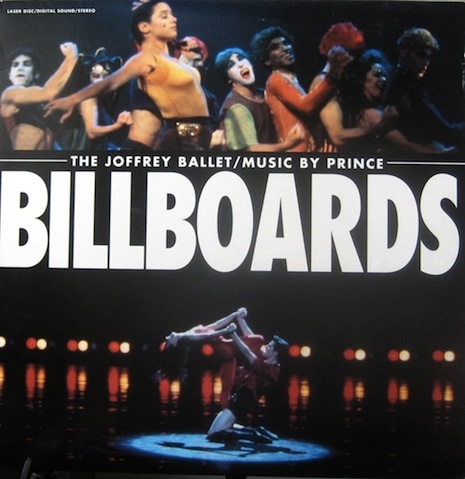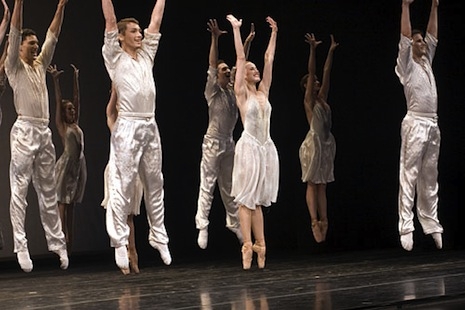
As an unabashedly “elite” pursuit, ballet has often struggled to find audience. Similar to opera only more so, ballet people have frequently obsessed about how to attract new demographic groups to its art. In 1993 the ballet world witnessed a fascinating experiment in crossing over: partnering with his Purple Badness himself, Prince—or, as he was known at that time, [unpronounceable glyph]—to create Billboards, mounted by the esteemed Joffrey Ballet. The legacy of Billboards is mixed, to say the least.
The Joffrey Ballet, founded in New York by Robert Joffrey and Gerald Arpino, has generally represented the more experimental end of the ballet spectrum. They were unafraid to commission works from figures from modern dance such as Alvin Ailey or Twyla Tharp. At some point, Prince caught some of the Joffrey Ballet’s “mixed rep,” and was so inspired that he pledged to compose some music for the troupe to perform to. Whether that actually happened is not entirely clear—the resultant 1993 ballet relies almost entirely on preexisting music, with the exception of a 10-minute orchestral version of “Thunder,” off of his 1992 album Diamonds and Pearls,which Prince did compose.

A still from the Joffrey Ballet’s 1993 work Billboards
Prince permitted the use of his catalog without asking for royalties. Billboards is a four-part piece, each part choreographed by a different person: Laura Dean, Charles Moulton, Margot Sappington, and Peter Pucci. Billboards raids liberally from Purple Rain, using the title track, “Baby I’m a Star,” “Computer Blue,” and “The Beautiful Ones,” as well as scattered picks off of Sign O’ the Times, Batman, Graffiti Bridge, Diamonds and Pearls, and Parade.
Here’s the breakdown of the pieces in Billboards and the songs they used:
I: Sometimes It Snows in April (choreographed by Laura Dean)
“Sometimes It Snows in April”
“Trust” / “Baby I’m a Star”II: Thunder (choreographed by Charles Moulton)
“Thunder”
“Purple Rain”III: Slide (choreographed by Margo Sappington)
“Computer Blue”
“I Wanna Melt with U”
“The Beautiful Ones”
“Release It” / “Computer Blue” (Reprise)IV: Willing & Able (choreographed by Peter Pucci)
“For You”
“The Question of U”
“It”
“Willing and Able” / “Gett Off”
Billboards premiered on January 27, 1993, at the University of Iowa’s Hancher Auditorium in Iowa City, Iowa. In November the piece moved to New York—where the critical reception was not altogether forgiving.
The first sentence of Anna Kisselgoff’s review in the New York Times of November 28, 1993, is “If only it had been better.” She continued:
“Billboards” is nonetheless an attempt to expand upon the company’s pioneering rock ballets of the past. ...
“Billboards” does not have the coherence and choreographic power of these works, but, like them, it sums up an era of pop esthetics. Similarly, its importance lies in an ability to interpret American youth culture to a mainstream dance audience—which should not be confused with its other goal of attracting new, young audiences.
“Billboards” could not have been done in the 1960’s; it evokes MTV with its frontal assault on the audience through loud sound and clever changes in lighting (by Howell Binkley). The choreography deliberately includes a great deal of posturing; there are also the coded gestures common to voguing, the dance style born in gay minority clubs and derived from fashion-model poses. ...
Rather than just exploit the varied range of Prince’s rhythms, they comment on the music and by extension, the rock scene as a whole.Working from a 1990’s safe-sex perspective, the choreographers ignore Prince’s calls for salvation through sex. MTV’s crotch-grabbing comes in for considerable parody. The naughtiness is tame: “Billboards” is a family show.
In the end, “Billboards” is only as good as its choreography, and here Ms. Dean, in the first section, “Sometimes It Snows in April,” is the clear winner. Prince’s ambiguous ballad about a dead friend is treated abstractly but lyrically by the choreographer, as the male and female dancers slink into diagonals, repeating turns and plies. New movement phrases overlap with the old. Individuals pair up for slow and amplified ballet lifts (the women are on toe).
Tobi Tobias in New York magazine was considerably harsher:
There have always been two Joffrey Ballets. One of them loves history. … The other company pays the bills.
Absent from the city for well over two years, … the Joffrey returned—for seven performances at [the Brooklyn Academy of Music]—with a single offering: the evening-length Billboards, to largely stupefying songs from Prince, its four sections choreographed separately. … It will find its audience, no doubt, but there will be few balletomanes in it. Indeed, one of the most horrifying things about this display is the murderous contempt it harbors for traditional dance values….
What else is wrong with Billboards? The choreography goes along with the premises of the music like so much visual accompaniment. Instead of providing a distanced irony or, at the very least, comment, it pretends to be part of Prince’s synthetically hip and orgiastic world and fails wretchedly; it looks like something resurrected from the sixties. Dean’s “Sometimes It Snows in April” is the only piece hurtling toward the junkyard of abandoned virtue that gives our old friends rhythm and pattern a backward glance. Still, it’s simplistic even for Dean and, as usual, opportunistic, incorporating her original trademarks, uninflected repetition and whirling; ballet conventions she annexed subsequently, working for the Establishment; and, to suit the present circumstances, her take on jazz movement, which is embarrassingly trite.
Margo Sappington’s “Slide” is the most viable entry, though I wouldn’t call it dancing. It’s a presentation in images of the teenage male’s romantic fantasies. A bunch of aw-shucks jocks from a past decade (the fifties that preceded Oh! Calcutta!?) conjure up a trio of sweetly lethal dreamboats for some inconclusive fooling around. Real choreography is irrelevant to the piece, which is essentially an amalgam of picturesque behavior and an effective set.
The show was a massive financial success, but just two years later the Joffrey Ballet found itself experiencing financial difficulties. According to The Oxford Dictionary of Dance by Debra Craine and Judith Mackrell, “In 1995 the Joffrey was suffering a financial crisis and had to relocate from New York to Chicago.”
Here’s an Australian TV piece about Billboards:
Here is a bit of Peter Pucci’s section of Billboards, “Willing & Able”:
Previously on Dangerous Minds:
Prince’s ‘Let’s Go Crazy’ gets a hard rock makeover
Ultra-hip TV: Prince’s 1997 appearance on ‘Muppets Tonight’





